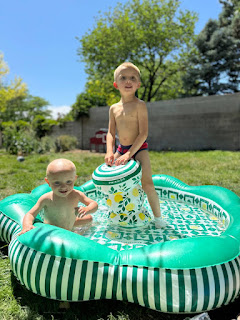This was slightly down (9%) from the 335 lbs I grew last year, but the 2023 garden was dominated by pumpkin and zucchini, which my family doesn’t like to eat. This year, there was a significantly greater percentage of tomato and cucumber, both of which my family eats a ton of.
In 2023, I kept totals, but did not spend the time performing this relative distribution analysis. Here’s the 2024 tabular data of the aggregates:
Pumpkin + zucchini + round zucchini (squash?) made up 54% of my garden. With what insane producers they are, this isn’t really a surprise. The pumpkins were mostly an accident, which came up from compost from the previous year’s crop.
The lone pepper plant still produced a decent amount of peppers (2.5lbs) which was interesting because that was the only one. It came from a gift of Babarba Dawson, owner of Purple Mulch, and a fellow 1,000,000 Cups supporter. She also gave me a number of my tomato seedlings, which were a nice addition to the ones I started.
Overall, I’m generally happy with this composition. We were able to avoid purchasing tomatoes and cucumbers for probably ⅓ of the year, and our processed tomato sauce lasted about another two months. I suspect to fill my family will need approximately 4x the tomato harvest (300 lbs) to last us an entire year, and it will take up substantial space in our freezer or panty. Likewise, I think we’ll need a similar increase in cucumber (4x, 200lbs) to grow all our own cucumbers. With both of these, the addition of dill and garlic will allow us to pickle any of the excess. The high acidity of tomatoes make me not particularly concerned about botulism if I attempt canning - my inexperience there makes me hesitant in anything low in acid.
We fed all of the inedible plant scraps to our chicken, and will compost her crap to turn it back into rich soil for the garden.
Future Improvements
Improve Plant Selection and Placement to Minimize Squash Bugs - Squash bugs are a constant problem, and basically impervious to poison. The only thing poison does for them is disrupt beneficial insects (spiders which eat them, ants to manage aphids, and bees as pollinators.) Due to the inefficiencies here, I went full organic and hand removed squash bugs. This was the biggest, consistent, use of my time in the garden. My plans for 2025 involve planting squash bug resistant squash, and placing two new raised beds in the front yard, far away from the back yard. I’ve also read about sacrificial crops that can be used, and heavily managed, to draw them away.
Improve Water Collection and Retention - I think I saved money by gardening, assuming the value of my time is $0.00 / hour, since I think it’s a fun hobby. However, our increased water bills were real and significant. It’s difficult for me to compute how much of this was garden related, versus grass yard establishment related. I believe the two improvements I can achieve here are better mulching, and beginning rainwater catchment systems. I first need eves on my buildings to direct the flow of water. These are basic carpentry, and/or metal work projects, and I can likely begin on them with a few simple tool purchases. The mulching should be cheap, or free, depending on my available materials. Rainwater collection can be a larger capital expenditure, which I am not sure about the break even time on. However, basic eaves should be relatively cheap and easy to construct and will be a good start.
Start Earlier - I got all of my plants into the ground before the end of April, with about half of them in by April 14 (about 50% probability of frost), and the rest before the end of April. Albuquerque’s last frost (around 10% probability of frost.) I believe I could have overplanted the seedlings, started them earlier inside (tomatoes for 40 days in advance, cucumbers, squash and pumpkins about 21 days in advance) and put 100% in around April 7. If a large number of them die, then I can replant seedlings, by planning 175-225% seedlings. This step is not very time consuming, as compared to preparing beds and (re)building irrigation systems.
Chickens - Our chicken needs additional security measures. We had three chickens, and something (a raccoon?) killed two of them. I believe the one chicken is a nice improvement, and I enjoy the garbage-to-eggs service the chicken provides, but chickens are supposed to be happier with a flock. I think we can support up to six chickens, with our household garbage, supplemental feed, space concerns and not being too annoying to our neighbors. This should also up my produce count, but likely not until the winter months if we get chicks in the spring.
Fruit Trees - Our fruit trees are the lowest labor producers, after they become established. If we’re able to border the entire perimeter of our property in fruit trees, we’ll be able to have fresh fruit harvests with minimal work. I’ve had the best luck with apples (they seem super hardy) and I’d like to get another apple tree and a peach tree in the ground.
Overall, I’m happy with how our 2024 garden turned out. There is always room for improvements, which need to be balanced against their costs and benefits, but I’m happy with how our backyard is transforming from stone, sand and plastic into something alive and productive. My goal for 2025 is 400 lbs, with no more than 40% of this coming from squash.










.jpg)





.jpg)
.jpg)





.jpg)














